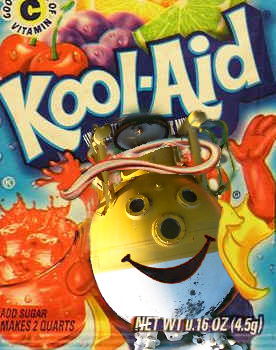Business is about feelings and emotions.
 If you use your sane-and-rational lenses and the situation doesn’t make sense, that’s because the situation is not governed by sanity and rationality. Yet, even though there’s a mismatch between the system’s behavior and sane-and-rational, we still try to understand the system through the cloudy lenses of sanity and rationality.
If you use your sane-and-rational lenses and the situation doesn’t make sense, that’s because the situation is not governed by sanity and rationality. Yet, even though there’s a mismatch between the system’s behavior and sane-and-rational, we still try to understand the system through the cloudy lenses of sanity and rationality.
Computer programs are sane and rational; Algorithms are sane and rational; Machines are sane and rational. Fixed inputs yield predicted outputs; If this, then that; Repeat the experiment and the results are repeated. In the cold domain of machines, computer programs and algorithms you may not like the output, but you’re not surprised by it.
But businesses are not run by computer programs, algorithms and machines. Businesses are run by people. And that’s why things aren’t always sane and rational in business.
Where computer programs blindly follow logic that’s coded into them, people follow their emotions. Where algorithms don’t decide what to do based on their emotional state, people do. And where machines aren’t afraid to try something new, people are.
When something doesn’t make sense to you, it’s because your assumptions about the underlying principles are wrong. If you see things that violate logic, it’s because logic isn’t the guiding principle. And if logic isn’t the guiding principle, the only other things that could be driving the irrationality are feelings and emotions. But if you think the solution is to make the irrational system behave rationally, be prepared to be perplexed and frustrated.
The underpinnings of management and leadership are thoughts, feelings and emotions. And, thoughts are governed by feelings and emotions. In that way, the currency of management and leadership is feelings and emotions.
If your first inclination is to figure out a situation using logic, don’t. Logic is for computers, and even that’s changing with deep learning. Business is about people. When in doubt, assess the feelings and emotions of the people involved. And once you understand their thoughts and feelings, you’ll know what to do.
Business isn’t about algorithms. Business is about people. And people respond based on their emotional state. If you want to be a good manager, focus on people’s feelings and emotions. And if you want to be a good leader, do the same.
Image credit: Guiseppe Milo
As a leader, your response is your responsibility.
 When you’re asked to do more work that you and your team can handle, don’t pass it onto your team. Instead, take the heat from above but limit the team’s work to a reasonable level.
When you’re asked to do more work that you and your team can handle, don’t pass it onto your team. Instead, take the heat from above but limit the team’s work to a reasonable level.
When the number of projects is larger than the budget needed to get them done, limit the projects based on the budget.
When the team knows you’re wrong, tell them they’re right. And apologize.
When everyone knows there’s a big problem and you’re the only one that can fix it, fix the big problem.
When the team’s opinion is different than yours, respect the team’s opinion.
When you make a mistake, own it.
When you’re told to do turn-the-crank work and only turn-the-crank work, sneak in a little sizzle to keep your team excited and engaged.
When it’s suggested that your team must do another project while they are fully engaged in an active project, create a big problem with the active project to delay the other project.
When the project is going poorly, be forthcoming with the team.
When you fail to do what you say, apologize. Then, do what you said you’d do.
When you make a mistake in judgement which creates a big problem, explain your mistake to the team and ask them for help.
If you’ve got to clean up a mess, tell your team you need their help to clean up the mess.
When there’s a difficult message to deliver, deliver it face-to-face and in private.
When your team challenges your thinking, thank them.
When your team tells you the project will take longer than you want, believe them.
When the team asks for guidance, give them what you can and when you don’t know, tell them.
As leaders, we don’t always get things right. And that’s okay because mistakes are a normal part of our work. And projects don’t always go as planned, but that’s okay because that’s what projects do. And we don’t always have the answers, but that’s okay because we’re not supposed to. But we are responsible for our response to these situations.
When mistakes happen, good leaders own them. When there’s too much work and too little time, good leaders tell it like it is and put together a realistic plan. And when the answers aren’t known, a good leader admits they don’t know and leads the effort to figure it out.
None of us get it right 100% of the time. But what we must get right is our response to difficult situations. As leaders, our responses should be based on honesty, integrity, respect for the reality of the situation and respect for people doing the work.
Image credit – Ludovic Tristan
Subtle Leadership
 You could be a subtle leader if…
You could be a subtle leader if…
You create the causes and conditions for others to shine. And when they shine, you give them the credit they’re due.
You don’t have the title, but when the high-profile project hits a rough patch, you get called in to create the go-forward plan.
One of your best direct reports gets promoted out from under you, but she still wants to meet with you weekly.
When you see someone take initiative, you tell them you like their behavior.
You get to choose the things you work on.
You can ask most anyone for a favor and they’ll do it, just because it’s you. But, because you don’t like to put people out, you rarely ask.
When someone does a good job, you send their boss a nice email and cc: them.
When it’s time to make a big decision, even though it’s outside your formal jurisdiction, you have a seat at the table.
When people don’t want to hear the truth, they don’t invite you to the meeting.
You are given the time to think things through, even when it takes you a long time.
Your young boss trusts you enough to ask for advice, even when she knows she should know.
In a group discussion, you wait for everyone else to have input before weighing in. And, if there’s no need to weigh in, you don’t.
When you see someone make a mistake, you ignore it if you can. And if you can’t, you talk to them in private.
Subtle leaders show themselves in subtle ways but their ways are powerful. Often, you see only the results of their behaviors and those career-boosting results are mapped to someone else. But if you’ve been the recipient of subtle leadership, you know what I’m talking about. You didn’t know you needed help, but you were helped just the same. And you were helped in a way that was invisible to others. And though you didn’t know to ask for advice, you were given the right suggestion at the right time. And you didn’t realize it was the perfect piece of advice until three weeks later.
Subtle leaders are difficult to spot. But once you know how they go about their business and how the company treats them, you can see them for what they are. And once you recognize a subtle leader, figure out a way to spend time with them. Your career will be better for it.
Image credit – rawdonfox
If the goal isn’t believable, it’s not achievable.
 I’m all for stretch goals to help people grow. “Hey, you did this last year but I think you can do ten percent more this year. And here’s why – [list three reasons here.]” This works. This helps people grow. This is effective. This is grounded in what happened last year. This is grounded in specific reasons why you think the stretch goal is possible. And when you do it this way, you are seen as credible.
I’m all for stretch goals to help people grow. “Hey, you did this last year but I think you can do ten percent more this year. And here’s why – [list three reasons here.]” This works. This helps people grow. This is effective. This is grounded in what happened last year. This is grounded in specific reasons why you think the stretch goal is possible. And when you do it this way, you are seen as credible.
Back in the day, when elite runners were running the mile in 4:04 their coaches said “Hey, you ran 4:04 last year but I think you can do it a little faster this year. I think you can run it in 3:59. And here’s why – your time has been decreasing steadily over the last three years, you have been working out with weights and you’re much stronger and there’s a small adjustment we can make to your stride that will help you be more efficient.
As an athlete, I believe this coach. It’s true, I did run 4:04 last year. It’s true, my time has decreased steadily over the last years. It’s true, I have been working hard in the weight room. And, because all these things are true, I believe the coach when she tells me she knows a way to help me run faster. This coach is credible and I will work hard for her.
Back in the day, when elite runners were running the mile in 4:04, their coaches did NOT say “Hey, as a stretch goal, I want you to run 2:59 next year. I know it’s a big improvement, but I want to set an arbitrary and unrealistic goal so I can get the most out of you. And no, I don’t have any advice on how you can run 27% faster than last year. As the one doing the running, that’s your job. I’m just the coach.”
As an athlete, I don’t believe this coach. There’s no way in hell I will run 27% faster this year. It’s simply not physically possible. The world record is 4:01 and I can’t break it by over a minute. The coach has no clue about how I can achieve the goal, nor did he build a bridge from last year’s pace to this silly target. This coach is not credible and I will not work hard for him.
As a leader you are credible when you set an improvement goal that’s grounded in the reality of how things have gone in the past. And you’re more credible when you give specific reasons why you think the improvement goal is possible. And you’re more credible when you give suggestions on how to achieve the goal. And you’re even more credible when you tell people you will actively support them in the improvement effort. When you do it this way, people think better of you and they’ll work hard for you.
Here’s a rule: if the goal isn’t believable it’s not achievable.
As a leader, when you set an improvement goal that’s out of line with reality you are NOT credible. When you declare an improvement goal that’s disrespectful of history, it’s not a stretch goal. It’s an arbitrary edict designed to trick people into working too hard. And everyone can spot these “goals” at twenty paces. Your best people will give you the courtesy of calling you on your disingenuous behavior, but most people will just smile and quietly think less of you. And none of them will work hard for you.
When the improvement goal isn’t credible, neither are you. Think twice before you ask your people to drink the company Kool-Aid.
Image credit – Andy
Productivity Through Prioritization
 If you haven’t noticed, the pace and complexity of our work is ever-increasing. There’s more to do and there are more interactions among the players and the tasks. And though there’s more need for thinking and planning, there’s less time to do it. And the answer from company leadership – more productivity.
If you haven’t noticed, the pace and complexity of our work is ever-increasing. There’s more to do and there are more interactions among the players and the tasks. And though there’s more need for thinking and planning, there’s less time to do it. And the answer from company leadership – more productivity.
With the traditional view of productivity, it’s do more with less. That works for a while and then it doesn’t. And when you can no longer do more, the only remaining way to improve productivity is to do less.
If you try to do all five things and get four done poorly, wouldn’t it be more productive if you tried to do only three things and did them well? None of the three would have to touched up or redone. And none of the three would occupy your emotional bandwidth because they were done well and they’re not coming back to bite you. And because you focused on three things, you spent only three things worth of energy. Your life force is conserved and when you get home you still have gas in the tank.
If you get three things done each day, you’ll accomplish more than anyone else in the company. Don’t think so? Three things per day is fifteen things per week. And if you work fifty weeks per year, three things per day is one hundred and fifty things per year. (I hope you don’t work fifty weeks per year, I chose this number because it makes the math cleaner.)
It’s not easy to get three things done per day. With meetings, email, texts and the various collaboration platforms, you have almost zero uninterrupted time. And with zero uninterrupted time, you get about zero things done. And if I have to choose between getting three things done or zero things done, I choose three. It’s difficult to allocate the time to get three things done, but it’s possible.
Three things may not seem like enough things, but three is enough. Here’s why. You don’t do just any three things, you do three important things. You choose what you want to get done and you get them done. The key is to decide which three things you’ll get done and which three hundred you won’t. To do this, take some time at the end of the day to define tomorrow’s three things. That way, first thing, you’ll get after the right three things. It’s productivity through prioritization. You’ve got to do fewer things to get more done.
And you can still deliver on large projects with the three-things-per-day method. For large projects, most, if not all, of the day’s three things should be directly related to the project. Remember the math – you can do fifteen things per week on a large project. And it works for long projects, too. Do one thing per week on the long project and you will accomplish fifty things over the course of the year. When was the last time you completed fifty things on a project?
And if you think three things is too few, that’s fine. If you want to do more than three things, you can. Just make sure you know which three you’ll complete before moving on to the fourth. But, remember, you want to leave work with some gas still in the tank so you can do three things when you get home.
Image credit – Steve @ the alligator farm
Seeing What Isn’t There
 It’s relatively straightforward to tell the difference between activities that are done well and those that are done poorly. Usually sub-par activities generate visual signals to warn us of their misbehavior. A bill isn’t paid, a legal document isn’t signed or the wrong parts are put in the box. Though the specifics vary with context, the problem child causes the work product to fall off the plate and make a mess on the floor.
It’s relatively straightforward to tell the difference between activities that are done well and those that are done poorly. Usually sub-par activities generate visual signals to warn us of their misbehavior. A bill isn’t paid, a legal document isn’t signed or the wrong parts are put in the box. Though the specifics vary with context, the problem child causes the work product to fall off the plate and make a mess on the floor.
We have tools to diagnose the fundamental behind the symptom. We can get to root cause. We know why the plate was dropped. We know how to define the corrective action and implement the control mechanism so it doesn’t happen again. We patch up the process and we’re up and running in no time. This works well when there’s a well-defined in place, when process is asked to do what it did last time, when the inputs are the same as last time and when the outputs are measured like they were last time.
However, this linear thinking works terribly when the context changes. When the old processes are asked to do new work, the work hits the floor like last time, but the reason it hits the floor is fundamentally different. This time, it’s not that an activity was done poorly. Rather, this time there’s something missing altogether. And this time our linear-thinker toolbox won’t cut it. Sure, we’ll try with all our Six Sigma might, but we won’t get to root cause. Six Sigma, lean and best practices can fix what’s broken, but none of them can see what isn’t there.
When the context changes radically, the work changes radically. New-to-company activities are required to get the new work done. New-to-industry tools are needed to create new value. And, sometimes, new-to-world thinking is the only thing that will do. The trick isn’t to define the new activity, choose the right new tool or come up with the new thinking. The trick is to recognize there’s something missing, to recognize there’s something not there, to recognize there’s a need for something new. Whether it’s an activity, a tool or new thinking, we’ve got to learn to see what’s not there.
Now the difficult part – how to recognize there’s something missing. You may think the challenging part is to figure out what’s needed to fill the void, but it isn’t. You can’t fill a hole until you see it as a hole. And once everyone agrees there’s a hole, it’s pretty easy to buy the shovels, truck in some dirt and get after it. But if don’t expect holes, you won’t see them. Sure, you’ll break your ankle, but you won’t see the hole for what it is.
If the work is new, look for what’s missing. If the problem is new, watch out for holes. If the customer is new, there will be holes. If the solution is new, there will be more holes.
When the work is new, you will twist your ankle. And when you do, grab the shovels and start to put in place what isn’t there.
Image credit – Tony Atler
Growth Isn’t The Answer
 Most companies have growth objectives – make more, sell more and generate more profits. Increase profit margin, sell into new markets and twist our products into new revenue. Good news for the stock price, good news for annual raises and plenty of money to buy the things that will help us grow next year. But it’s not good for the people that do the work.
Most companies have growth objectives – make more, sell more and generate more profits. Increase profit margin, sell into new markets and twist our products into new revenue. Good news for the stock price, good news for annual raises and plenty of money to buy the things that will help us grow next year. But it’s not good for the people that do the work.
To increase sales the same sales folks will have to drive more, call more and do more demos. Ten percent more work for three percent more compensation. Who really benefits here? The worker who delivers ten percent more or the company that pays them only three percent more? Pretty clear to me it’s all about the company and not about the people.
To increase the number of units made implies that there can be no increase in the number of people required to make them. To increase throughput without increasing headcount, the production floor will have less time for lunch, less time for improving their skills and less time to go to the bathroom. Sure, they can do Lean projects to eliminate waste, as long as they don’t miss their daily quota. And sure, they can help with Six Sigma projects to reduce variation, as long as they don’t miss TAKT time. Who benefits more – the people or the company?
Increased profit margin (or profit percentage) is the worst offender. There are only two ways to improve the metric – sell it for more or make it for less. And even better than that is to sell it for more AND make it for less. No one can escape this metric. The sales team must meet with more customers; the marketing team must work doubly hard to define and communicate the value proposition; the engineering staff must reduce the time to launch the product and make it perform better than their best work; and everyone else must do more with less or face the chopping block.
In truth, corporate growth is the fundamental behind global warming, reduced life expectancy in the US and the ridiculous increase in the cost of healthcare. Growth requires more products and more products require more material mined, pumped or clear-cut from the planet. Growth puts immense pressure on the people doing the work and increases their stress level. And when they can’t deliver, their deep sense of helplessness and inadequacy causes them to kill themselves. And healthcare costs increase because the companies within (and insuring) the system need to make more profit. Who benefits here? The people in our community? The people doing the work? The planet? Or the companies?
What if we decided that companies could not grow? What if instead companies paid dividends to the people do the work based on the profit the company makes? With constant output wouldn’t everyone benefit year-on-year?
What if we decided output couldn’t grow? What if instead, as productivity increased, companies required people to work fewer hours? What if everyone could make the same number of products in seven hours and went home an hour early, working seven and getting paid for eight? Would everyone be better off? Wouldn’t the planet be better off?
What if we decided the objective of companies was to employ more people and give them a sense of purpose and give meaning to their lives? What if we used the profit created by productivity improvements to employ more people? Wouldn’t our communities benefit when more people have good jobs? Wouldn’t people be happier because they can make a contribution to their community? Wouldn’t there be less stress and fewer suicides when parents have enough money to feed their kids and buy them clothes? Wouldn’t everyone benefit? Wouldn’t the planet benefit?
Year-on-year growth is a fallacy. Year-on-year growth stresses the planet and the people doing the work. Year-on-year growth is good for no one except the companies demanding year-on-year growth.
The planet’s resources are finite; people’s ability to do work is finite; and the stress level people can tolerate is finite. Why not recognize these realities?
And why not figure out how to structure companies in a way that benefits the owners of the company, the people doing the work, the community where the work is done and the planet?
Image credit – Ryan
How to Prevent Depletion
 On every operating plan there are more projects than there are people to do them and at every meeting there more new deliverables than people to take them on. At every turn, our demand for increased profits pushes our people for more. And, to me, I think this is the reason every day feel fuller than the last.
On every operating plan there are more projects than there are people to do them and at every meeting there more new deliverables than people to take them on. At every turn, our demand for increased profits pushes our people for more. And, to me, I think this is the reason every day feel fuller than the last.
This year do you have more things to accomplish or fewer? Do you have more meetings or fewer? Do you get more emails or fewer?
We add work to people’s day as if their capacity to do work is infinite. And we add metrics to measure them to make sure they get the work done. And that’s a recipe for depletion. At some point, even the best, most productive people reach their physical and emotional limits. And at some point, as the volume of work increases, we all become depleted. It’s not that we’re moving slowly, being wasteful or giving it less than our all. When the work exceeds our capacity to do it, we run out of gas.
Here are some thoughts that may help you over the next year.
The amount of work you will get done this year is the same as you got done last year. But don’t get sidetracked here. This has nothing to do with the amount of work you were asked to do last year. Because you didn’t complete everything you were asked to do last year, the same thing will happen this year unless the amount of work on this year’s plan is equal to the amount of work you actually accomplished last year. Every year, scrub a little work off your yearly commitments until the work content finally equals your capacity to get it done.
Once the work content of your yearly plan is in line, the mantra becomes – finish one before you start one. If you had three projects last year and you finished one, you can add one project this year. If you didn’t finish any projects last year you can’t start one this year, at least until you finish one this year. It’s a simple mantra, but a powerful one. It will help you stop starting and start finishing.
There’s a variant to the finish-before-you-start approach that doesn’t have to wait for the completion of a long project. Instead of finishing a project, unimportant projects are stopped before they’re finished. This is loosely known as – stop doing before start doing. Stopping is even more powerful than finishing because low value work is stopped and the freed-up resources are immediately applied to higher value work. This takes judgement and courage to stop a dull project, but it’s well worth the discomfort.
If you want to get ahead of the game, create a stop-doing list. For each item on the list estimate how much time you will free up and sum the freed-up time for the lot. Be ruthless. Stop all but the most important work. And when your boss says you can’t stop something because it’s too important, propose that you stop for a week and see what happens. And when no one notices you stopped, propose to stop for a month and see what happens. Rinse and repeat.
When the amount of work you have to get done fits with your capacity to do it, your physical and mental health will improve. You’ll regain that spring in your step and you’ll be happier. And the quality of your work will improve. But more importantly, your family life and personal relationships will improve. You’ll be able to let go of work and be fully present with your friends and family.
Regardless of the company’s growth objectives, one person can only do the work of one person. And it’s better for everyone (and the company) if we respect this natural constraint.
On Gumption
 Doing new work takes gumption. But there are two problems with gumption. One, you’ve got to create it from within. Two, it takes a lot of energy to generate the gumption and to do that you’ve got to be physically fit and mentally grounded. Here are some words that may help.
Doing new work takes gumption. But there are two problems with gumption. One, you’ve got to create it from within. Two, it takes a lot of energy to generate the gumption and to do that you’ve got to be physically fit and mentally grounded. Here are some words that may help.
Move from self-judging to self-loving. It makes a difference.
It’s never enough until you decide it’s enough. And when you do, you can be more beholden to yourself.
You already have what you’re looking for. Look inside.
Taking care of yourself isn’t selfish, it’s self-ful.
When in doubt, go outside.
You can’t believe in yourself without your consent.
Your well-being is your responsibility. And it’s time to be responsible.
When you move your body, your mind smiles.
With selfish, you take care of yourself at another’s expense. With self-ful, you take care of yourself because you’re full of self-love.
When in doubt, feel the doubt and do it anyway.
If you’re not taking care of yourself, understand what you’re putting in the way and then don’t do that anymore.
You can’t help others if you don’t take care of yourself.
If you struggle with taking care of yourself, pretend you’re someone else and do it for them.
Image credit — Ramón Portellano
Advice To Young Design Engineers
If your solution isn’t sold to a customer, you didn’t do your job. Find a friend in Marketing.
If your solution can’t be made by Manufacturing, you didn’t do your job. Find a friend in Manufacturing.
Reuse all you can, then be bold about trying one or two new things.
Broaden your horizons.
Before solving a problem, make sure you’re solving the right one.
Don’t add complexity. Instead, make it easy for your customers.
Learn the difference between renewable and non-renewable resources and learn how to design with the renewable ones.
Learn how to do a Life Cycle Assessment.
Learn to see functional coupling and design it out.
Be afraid but embrace uncertainty.
Learn how to communicate your ideas in simple ways. Jargon is a sign of weakness.
Before you can make sure you’re solving the right problem, you’ve got to know what problem you’re trying to solve.
Learn quickly by defining the tightest learning objective.
Don’t seek credit, seek solutions. Thrive, don’t strive.
Be afraid, and run toward the toughest problems.
Help people. That’s your job.
Image credit – Marco Verch
An Environmental Call-To-Arms for Industry
 What is your obligation to improve the health of our planet?
What is your obligation to improve the health of our planet?
For the CEO – Look around. Look at Europe. Look at China’s plans. Look at the startups. I know you want to achieve your growth objectives, but if you don’t take seriously the race toward cleaner products and services, you’ll go out of business. You can see this as a problem or an opportunity. Bury your head or put on your track shoes and run! It’s your choice.
Look at the oceans. Look at the landfills. Look at the rise in global temperatures. Just look. This isn’t about ROI, this is about survival. Growth objectives aside, no one will buy things when they are struggling to survive in an uncertain future. Your same old dirty products won’t cut it anymore. So, what are you going to do?
For an example of a path forward, look to the companies in the oil business. Their recipe is clear. They’ve got to use their large but ever-diminishing profits to buy themselves into technologies and industries that will ultimately eat their core business. Though the timing is uncertain, it’s certain that improvements in cleaner technologies will demand they make the change.
Whatever you do, don’t wait. You don’t have much time. Cleaner technologies are getting better every day. It’s time to start.
For Marketing – Look at the upstarts. Look at the powerful companies in adjacent markets who will soon be your direct competitors. Look at your stodgy, unprofitable competitors who are now sufficiently desperate to try anything. Their next marketing push will be built on the bedrock of an improved planet. They’ll be almost as good as you in the traditional areas of productivity and quality and they’ll blow your doors off with their meaner and greener products. Customers will choose green over brown. And they’ll look for real improvements that make the planet smile. The time for green-washing is past. That trick is out of gas.
You need to help customers with new jobs to be done. They care about their environment. They care about their carbon footprint. They care about clean water. And they care about recycling and reuse. It’s real. They care. Now it’s up to you to help them make progress in these areas. It will be a tough road to convince your company that things need to change, but that’s why you’re in Marketing.
You’re already behind. It’s time to start. And it’s up to you to lead the charge.
For Manufacturing – Look at your Value Stream Maps (VSMs). Assign a carbon footprint to each link in the chain. And do the same with water consumption. Assess each process step for carbon and water and rank them worst to best. For the worst, run carbon kaizens and improve the carbon footprint. And run water kaizens for the thirstiest processes.
And look again at your VSMs, and look more broadly. Look back into the supply chain, rank for carbon and water and improve the ones that need the treatment. And teach your suppliers how to do it. And look forward into your distribution channels and improve or eliminate the worst actors. And then propose to Marketing that you teach your customers how to use VSMs to clean up their act. And challenge Engineering to change the design to eliminate the remaining bad actors.
You’ve made good progress with your value streams. Now it’s time to help others make the progress that must be made. As subject matter experts, it’s your time to shine. And, please, start now.
For Engineering – Look at your products. Look at how they’re used. Look at how they’re delivered. Look at how they’re made. Look at how they’re recycled. Sure, your products provide good functionality, but throughout their life cycle they also create carbon dioxide and consume water. And you’re the only ones that can design out the environmental impact.
Learn how to do a Life Cycle Assessment (LCA). Learn which elements of the product create the largest problems. For all the parts that make up the product, sort them worst to best to prioritize the design work. It’s time for radical part count reduction. Try to design out half the parts. It’s possible. And the payoff is staggering. What’s the carbon footprint of a part that was designed out of the product?
Or, to make a more radical improvement, consider an Innovation Burst Event (IBE) to make a fundamental change in the way your products/services impact the environment. With this approach, your innovation work, by definition, will make the planet smile.
It’s time to be open-minded. Ask Manufacturing for the worst processes (including supply chain and distribution) and try to design them out. Design out the part, or change the material, or change the design to enable a friendlier process. Manufacturing can only improve a bad process, but you can design them out altogether. There’s power in that, but with power comes responsibility.
And it’s time for you to take responsibility.
For Everyone in Industry – Regardless of your company, your country or your political affiliation, we can all agree that all our lives get better as the health of our planet improves. And everyone can agree that cleaner air is better. And everyone can agree it’s the same for our water – cleaner is better. And that’s a whole lot of agreement.
As industry leaders, I challenge you to build on that common ground. As industry leaders, I challenge you to improve our planet one product at a time and one process at a time. And as industry leaders, I challenge you to help each other. There’s no competitive disadvantage when you help a company outside your industry. And there’s no shame in learning from companies outside your industry. And it’s good for the planet and profits. There’s nothing in the away. It’s time to start.
As an industry leader, if you want to make a difference in the health of our planet, send me an email at mike@shipulski.com and we will help each other.
Image credit – halfrain

 Mike Shipulski
Mike Shipulski